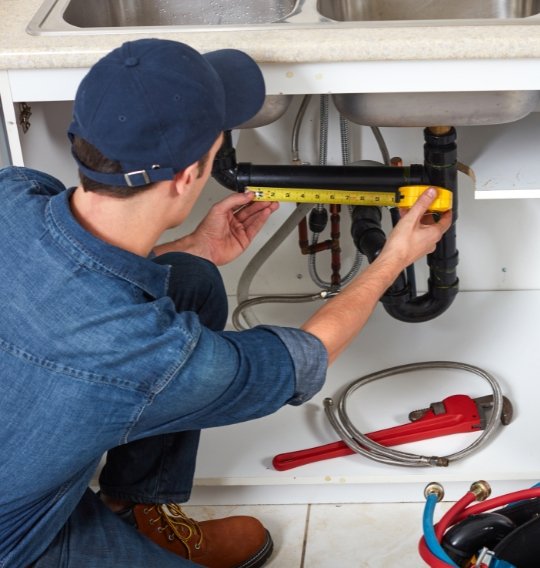While both new and old houses can experience plumbing issues, the types and frequency of problems may vary. Here are some common plumbing problems faced in new and old houses:
Plumbing problems in old houses:
Galvanized pipes: Older homes often have galvanized pipes, which can corrode over time and lead to leaks, reduced water pressure, and discolored water.
Sewer line issues: Aging sewer lines made of clay or cast iron can crack or collapse, causing blockages or backups.
Outdated fixtures: Older fixtures may be less efficient and more prone to leaks or other issues, which can lead to increased water usage and higher utility bills.
Corroded or damaged plumbing connections: Over time, plumbing connections can become corroded or damaged, increasing the risk of leaks and water damage.
Inadequate water pressure: Older homes may have inadequate water pressure due to corroded pipes or outdated plumbing systems.
Plumbing problems in new houses:
Improper installation: New houses may experience plumbing issues due to improper installation, such as poorly connected pipes or incorrectly installed fixtures.
Construction debris: Debris from construction, such as drywall dust or sawdust, can clog pipes and cause drainage issues in new homes.
Expanding/contracting pipes: Newly installed pipes may expand and contract during temperature fluctuations, causing noise or movement in the plumbing system.
Manufacturing defects: New plumbing fixtures or components may have manufacturing defects, which can lead to leaks or other issues.
Incompatible materials: Some new homes may use incompatible materials in the plumbing system, which can cause premature failure or leaks.
To prevent and address plumbing problems in both new and old houses, homeowners should:
Schedule regular plumbing inspections and maintenance to identify and fix potential issues before they become emergencies.
Replace old or corroded pipes with newer, more durable materials like copper or PEX.
Install water pressure regulators and water softeners to protect the plumbing system from damage.
Ensure proper installation and use of plumbing fixtures and components to prevent leaks and other issues.
Be aware of the specific plumbing issues that may be more common in their type of home and take appropriate preventative measures.
Issues and Solutions for Common Plumbing Problems
Burst or leaking pipes:
Issue: Pipes can burst or leak due to corrosion, extreme temperature changes, or accidental damage during construction or landscaping projects.
Solution: Regularly inspect your plumbing system for signs of wear and tear or damage. Insulate pipes during colder months to prevent freezing and bursting. If you detect a leak or burst pipe, shut off the main water supply and contact a professional plumber immediately.
Clogged drains and toilets:
Issue: Hair, soap scum, grease, and foreign objects can cause blockages in drains and toilets, leading to slow draining water or overflowing.
Solution: Use a drain strainer to catch debris and avoid disposing of grease, oil, and non-flushable items in drains and toilets. For minor clogs, use a plunger or a drain snake to clear the blockage. If the problem persists, contact a plumber to assess and address the issue.
Sewer backups or blockages:
Issue: Tree roots, debris, or structural damage can cause sewer line blockages or leaks, resulting in unpleasant odors or sewage backups in your home.
Solution: Schedule regular sewer line inspections and maintenance to detect and address potential issues before they become emergencies. If you suspect a sewer line issue, contact a professional plumber to diagnose and repair the problem.
Gas leaks detection and repair:
Issue: Gas leaks can pose a significant safety risk and should be addressed immediately.
Solution: Install a gas leak detector in your home and familiarize yourself with the smell of natural gas. If you suspect a gas leak, evacuate the area, shut off the gas supply, and contact a professional plumber or your gas company for assistance.
Water heater repair or replacement:
Issue: Issues with water heaters can lead to a lack of hot water, inconsistent temperatures, or leaks. These problems may stem from sediment buildup, faulty heating elements, or a damaged pressure relief valve.
Solution: Schedule regular water heater maintenance and inspections to ensure optimal performance. If you encounter issues with your water heater, contact a plumber for diagnosis and repair or replacement, if necessary.
Faucet and fixture repair or replacement:
Issue: Dripping faucets and showerheads can waste water and lead to higher utility bills. These issues are often caused by worn-out washers, seals, or O-rings.
Solution: Regularly inspect faucets and fixtures for signs of wear or leaks. If you detect a problem, replace the worn parts or consult with a plumber for repair or replacement.
Garbage disposal repair:
Issue: Misuse or lack of maintenance can lead to garbage disposal jams, leaks, or malfunctions.
Solution: Run cold water while using the disposal, avoid disposing of hard or fibrous materials, and clean your garbage disposal regularly with ice and citrus peels. If your garbage disposal experiences issues, contact a plumber for repair or replacement.
Emergency shut-off valve installation and repair:
Issue: A malfunctioning emergency shut-off valve can cause flooding or water damage in your home.
Solution: Familiarize yourself with the location of your home’s main shut-off valve and test it periodically to ensure proper function. If you experience issues with your shut-off valve, contact a plumber for repair or replacement.

